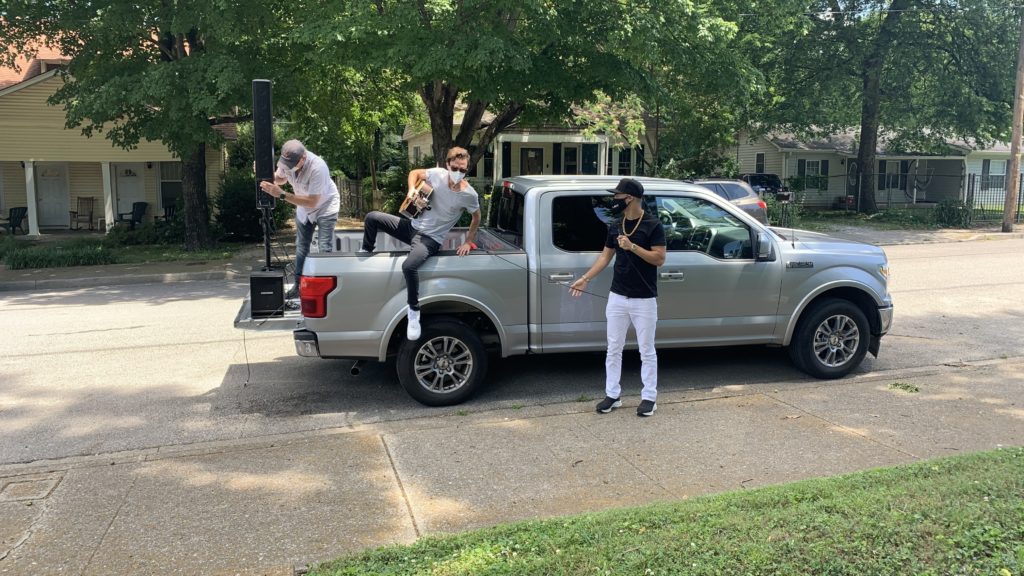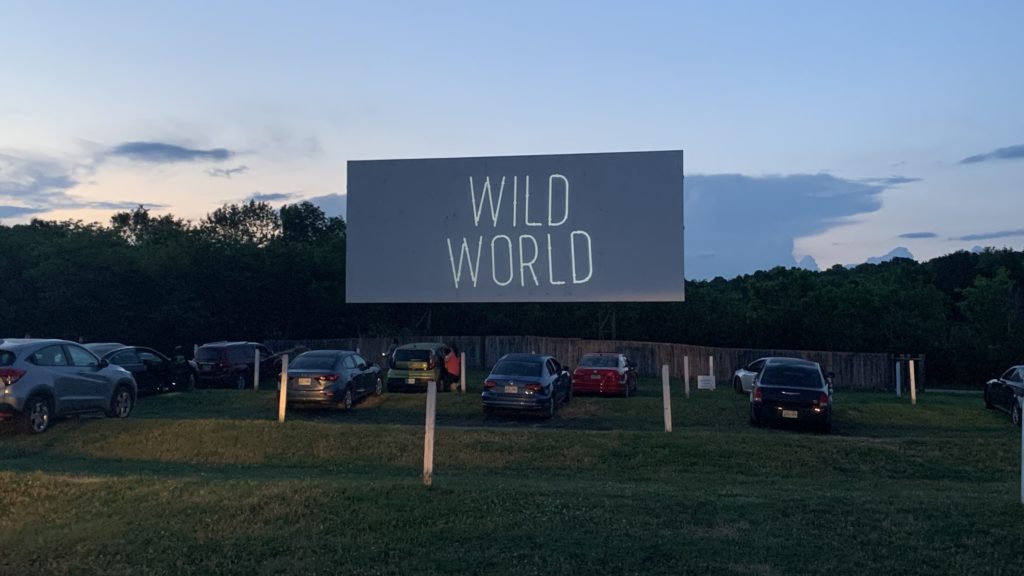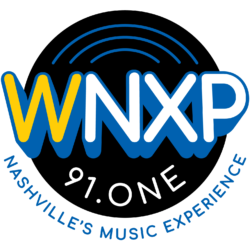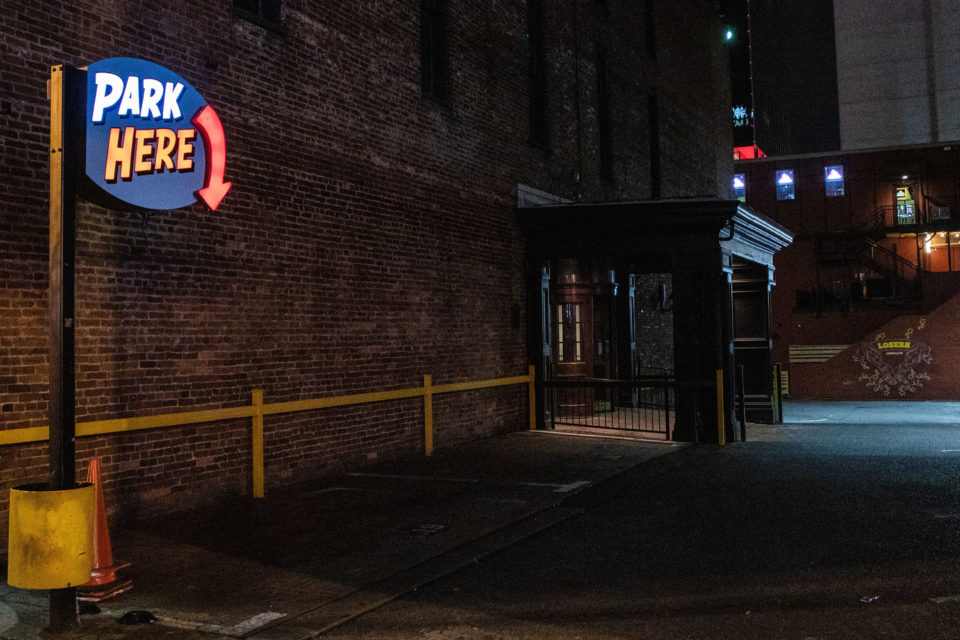The early experiments in COVID-19-era concerts have been watched closely, because the stakes are clearly high on both sides of the coin: the possibility of salvaging lost musical livelihoods has to be balanced against any potential exposure risks for all involved. So far, country acts seem to have outpaced those in other genres when it comes to experimenting with live show layouts, from those that separate pods of attendees in vehicles or outdoor suites to those that let audience members cram in shoulder to shoulder, just like the good, old, pre-pandemic days.
But concerts aren’t the only career-furthering events that the Nashville industry has been going without. Another type of gathering routinely happens out of public view, its function to promote new acts and new music to industry gatekeepers, tastemakers and professional peers. Often, a small bar or venue will be rented out for these boozy, schmoozy shindigs. It’s about getting face time, as opposed to FaceTime, so artists will work the room making friendly conversation. If they’re new to the game, they’re likely to have a publicist by their side providing guidance and making introductions.Of course, lockdown brought those rituals to a halt too, but attempts to safely (and resourcefully) replace them have begun.
Country success tends to require staunch participation in the Nashville community. That’s one of the many reasons that Lil Nas X’s winking, cowboy-burlesquing, hip-hop virality seemed so out of step with country music’s establishment, at least initially — he pulled it off without them.
Today’s centralized country music industry is the result of once geographically, culturally and stylistically disparate and distinct threads being woven into a consolidated, popular (and artificially whitewashed) format, with its business and creative infrastructure and towering historical narrative staunchly headquartered in Nashville. It’s not easy to launch and sustain a recording and touring career in this world without winning over some of its major players, securing the approval, opportunities, institutional support and media coverage they have to give. Performing know-how matters, but so does being eager and personable.
So the events where up-close access happens do serve a real purpose: The albums that were released rather than postponed just after the nation went into quarantine — which included established names at pivotal points in their careers, like Ashley McBryde, Sam Hunt, Kelsea Ballerini and Maddie & Tae, and promising country-pop newbie Ingrid Andress — likely forfeited some of the recognition they might have gotten if plans to promote them in person hadn’t been canceled out of necessity. It’s no wonder that record label, management and publicity staff are seeking innovative stopgaps.
Just over a week before the release of the debut country single by Shy Carter — a biracial, Memphis-bred, singer-rapper who had a decade of pop-R&B, hip-hop and country songwriting credits and guest spots under his belt, but was new to the Warner Nashville roster — a label rep emailed with the offer of an “At-Home Artist Visit.” The proposed scenario involved Carter giving some sort of brief performance on a flatbed truck that would be parked in front of my residence. I was too curious, about both the extravagance of the scheme and the act it was meant to introduce, to decline.
As it turned out, what rolled up in front of my house around lunchtime that Friday wasn’t an industrial hauler at all — just a shiny, silver pickup.
A guy who identified himself as Carter’s brother hopped out the passenger side first, followed by Carter himself, both of them extending greetings. I asked Carter how many stops he’d already covered on his mini-tour that day. This was only his second, he reported brightly, implying the specialness of the visit.
The driver walked to the back of the truck, lowered the tailgate and slid a small portable PA onto it, while Carter’s sole live accompanist swung his legs over the side of the truck bed and perched there, balancing an acoustic guitar on his lap. The remaining two members of the entourage, one of them a publicist, emerged from a second vehicle, keeping a respectable distance on the sidewalk. A few neighbors walked over and spread out in the yard to watch.
We were all wearing fabric face masks, but Carter removed his to sing into a microphone, revealing a luminous smile. He was a seasoned and charismatic enough entertainer to seem entirely unfazed by the awkwardness of serenading me from my sidewalk.

Jewly Hight
He started off with the single “Good Love,” a tune whose broad, breezy optimism could be heard as social or romantic. Over the backing track’s beat and the guitarist’s strumming, Carter applied suavely understated syncopation to his vocal cadence, bobbing as he sang. He did a playful beatboxing interlude before launching into his second and final selection, a rendition of Charlie Puth’s wispy, 2015 pop hit “One Call Away,” which Carter had co-written, and now took in an appealing, southern-soul direction. He waved his arms and held his mic in the air during the next-to-last refrain, encouraging crowd participation. When he reached the final line, he sang, “I’m only one,” then interrupted himself to playfully interject “if you want me to come do a show at your porch,” and finished “call away” with a short vocal run.
There was more beatboxing, and an invitation to everyone present to dance along. Then the mobile busking session was over. Carter chatted amiably with me across the grass while his crew packed up, and I let him know I appreciated the work-day diversion. Before getting back in her car, his publicist reminded me to be on the lookout for the single. As industry-facilitated first impressions go, it was downright effective.
I detected a bit more urgency to the rollout of the debut album from Gabby Barrett. Hailing from a Pittsburgh suburb, Barrett is one of the very few new, female acts to crack the code of country radio programming practices that have long been demonstrably biased against women. Her first single, “I Hope,” a satisfyingly simmering emotional revenge fantasy, scaled Billboard’s Country Airplay and Hot Country Songs charts in April on the strength of its streaming and airplay numbers, and her label, the same one as Carter’s, considered her a real commercial contender. As a singer, she could be sultry or commanding and athletic, capable of occasionally flying up to a Mariah Carey-style whistle register, and was schooled on the big, bold-faced gestures of gospel, R&B and country-pop. The momentum Barrett had already built was too precious to squander.
To that end, I was invited to take part in a weekday afternoon, small-group Zoom session the week her album, Goldmine, dropped. In the days leading up to the virtual function, two mysterious boxes arrived at my house. The first, I’m told, contained an Amazon Echo Studio smart speaker, part of a cross-promotional initiative (it stayed in the box and was returned unused). The second package wasn’t to be opened until we were all video conferencing with Barrett; this would be a Q&A with interactive props.
Cris Lacy, the Warner A&R executive serving as moderator, offered a bit of clarification. “I do wanna let you know that everything in the box was selected by Gabby,” she said, “except for the champagne.” Having turned 20 just a few months before, Barrett wasn’t yet of sparkling wine-selecting age.
In front of a small audience of institutional and media gatekeepers who’d logged on from far-flung locations, Lacy emphasized her belief in Barrett and prompted the young singer to talk about a variety of topics, all of them indicating her readiness for the Nashville spotlight. Obligingly, Barrett described her early performing start and the decade of experience she’d already accumulated, as a soloist in a gospel choir (further reading reveals she was one of the few white voices in a predominately Black church ensemble), a precocious regional entertainer tackling wide-ranging covers with backing tracks and a 2018 American Idol finalist who drew comparisons to Carrie Underwood. Even after that television exposure, Barrett let us know she had to continue to hustle on tour and make inroads working with recognized Music Row writers and producers before landing her record deal. She expressed gratitude for the ways the industry had welcomed her already.
Lacy sought to highlight Barrett’s perfectionistic drive, asking her about how she pulled off a last-minute vocal fix for her album during quarantine by singing into her phone and zeroed in on subtleties that no one else heard during the mixing process. Lacy marveled that Barrett chose to rewrite a song that had long been in her live repertoire, “Jesus & My Mama,” so that the version on her album would better reflect her spiritual commitment.
Now it was time for us to rummage around in our boxes of trinkets (all in shiny gold wrapping, in accordance with Barrett’s color scheme) and locate the pendant with two tiny, entwined hoops — a sort of Venn diagram of faith and family — that corresponded with the tune. When the topic shifted to her hit “I Hope,” we could see her holding up a small, rectangular item on screen. “I went with a matchbox just because the song’s a very fiery song and it just gives off that flame-red vibe,” she explained. There was a blue tea light to go with the remix of “I Hope,” featuring Charlie Puth, a Bible for “Got Me,” a devotional ballad featuring the acoustic worship duo Shane & Shane, and a little tin emblazoned with horses and containing vanilla fudge for her current single, “The Good Ones,” in tribute to the steadiness of her Texan husband, Cade Foehner.
We participants played along, searching for the right items on cue and, when it was our turn, chiming in with questions of our own. Several people warmly congratulated Barrett on her album before signing off, helping put a sociable gloss on a promotional exchange.
New release events are considered important rituals even for established acts — like Kip Moore, a heartland rocker whose reputation evolved from radio hit-making to making an earnest display of seeking meaning on his increasingly self-sufficient song cycles. Moore’s fourth album, Wild World, was coming out, so he and his team planned one of the industry’s few in-person gatherings in recent memory. Not at a Nashville spot, but a small-town drive-in movie theater 45 minutes east. They sent a special ticket in advance, along with logistical information that showed they’d put a lot of thought into how to minimize contact. (Moore also had a public show booked for a shuttered prison-turned-venue in August, but when photos circulated of a mask-less, packed-in crowd watching Chase Rice play the place in June, Moore’s date was canceled.) The biggest barrier to the release event was simply getting to the theater. The drive was roughly half interstate and half two-lane country road, passing a few strip malls that gave way to churches and cow pastures.

Jewly Hight
We were instructed to tune our radios to the theater’s frequency of 87.9, to hear Moore’s latest playing on repeat, and drive toward a pop-up tent where we could open our trunks and let gloved, masked staffers place sanitized bags of merch (a Moore bandana and CD) and snacks (bottled water, popcorn and Twizzlers) inside, without contact. After parking in neat rows between wooden posts, we were encouraged to stay in our vehicles. Bathroom access was limited to one person at a time. Most attendees complied, although a few congregated to chat. At least one put the bandana — emblazoned with “Shoulda been an OUTLAW,” a big-talking line from the song “Southpaw” — to immediate use as a face covering. Two women who arrived together spread a towel on the roof of their small SUV and climbed up for an elevated view of the show.
The screening of Moore’s short documentary was to start as soon as the sun went down. To add a necessary live component and enable limited interaction, satellite radio personality Storme Warren and Moore served as emcees. They perched on stools on a small stage set up behind the cars, the camera aimed at them beaming its feed onto the screen.
Moore explained that he’d had to scrap his initial plans to shoot a musical travelogue and instead get most of the footage during his first week quarantining at the rock climbers’ lodge he and friend built in Kentucky’s Red River Gorge. “If your car stereo sucks, this is going to be a long night,” he quipped, acknowledging that the arrangement didn’t allow the level of hobnobbing access that such a shindig ordinarily would. “I don’t know if you’re smiling in your cars right now, but I hope y’all love this.”
The movie was full of bucolic scenery. Sitting on his porch one misty morning, Moore mused about his introverted contentment with isolation: “I could sit in this rocking chair and drink coffee and read books all day.” Then he was in motion, winding down country roads in a car or on a skateboard, scaling rugged rock faces with a couple of close friends. A shot of him shirtless elicited an appreciative shout from the occupant of a nearby vehicle.
Songs that received the wiry, full-band treatment on Moore’s album were rendered as acoustic ruminations in the film. At its emotional center was one, titled “Payin’ Hard,” that he sang in raspy, rapt a capella, sat next to a fire: “My life’s a credit card, play now, pay later, and I’m payin’ hard.”
He paused before continuing his stoic consideration of actions’ consequences: “I’ll live with that, sleep with that, and I’ll make my peace and die with that, yeah.”
The audience clapped and honked at the end of the documentary, and Moore and Warren returned to the screen. “Do you recognize that sound?” Warren asked his interviewee with feigned amazement. “It’s called applause.”
During their conversation, Moore reiterated his presentation of himself as a restless, soul-searching type. “I think I’m understanding myself more now than I ever have,” he declared. It was also a chance for him to reframe the music he’d written and recorded for Wild World. That work happened long before lockdown, but he looked at it as preparation for this forced pause in professional activity, since he’d already settled on the theme of “finding the joy in simplicity.”
The sentiment resonated, because so many of us had been trying to do the same thing. But pulling off an event like that, one that broke from tried-and-true templates, didn’t seem simple at all.

